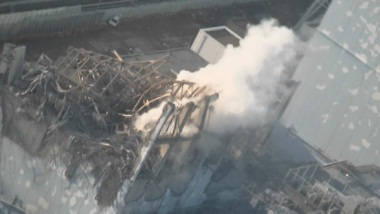Progress by on-site workers
17 March 2011
FIRST PUBLISHED: 4.56pm
UPDATE 1: 5.22pm Addition of image
The high levels of radiation braved by workers at the scene in Fukushima Daiichi appear to have reduced after the expansion of the workforce and announcements of infrastructure improvements to come.
In recent days emergency managers were faced with an extremely complicated task to prioritise jobs across all four struggling reactor units in the main part of the site, while a skeleton operating crew maintained the status of units 5 and 6 about two hundred metres away.
There have been about 50 staff engaged in pumping seawater into the reactor cores and primary containment vessels of units 1, 2 and 3. From time to time these need to vent steam, which causes radiation to rise across the site and required the workers to move to a safer location.
Another 130 were also on site, according to reports, including soldiers from the Japan Self Defence Force.
Normally nuclear workers are allowed to receive a dose of 20 millisieverts per year, although in practice they often receive very much less. If that limit is exceeded in any year, the worker cannot undertake nuclear duties for the remainder.
 |
| A helicopter shot of Fukushima Daiichi 3 earlier today |
In emergency circumstances safety regulators allow workers to receive up to 100 millisieverts with the same conditions applying, that they must leave the site should that limit be reached. The 100 millisievert level is roughly the point at which health effects from radiation become more likely. Below this it is statistically difficult to connect radiation dose to cancer rates, but above this the relationship starts to become apparent.
Under a special allowance from the Nuclear and Industrial Safety Agency, workers at Fukushima were permitted doses of up to 250 millisieverts. Managers must be careful to make the best use of those experienced workers with the most detailed knowledge and experience of the plant.
The small workforce battled to spray water into the damaged buildings of units 3 and 4, working when and where they could to avoid exceeding those radiation dose limits. World Nuclear News understands that the army fire engine was able to "deliver 30 tonnes of water" towards or into unit 3's fuel pond, but this is not confirmed, nor is the expected drop in radiation levels expected to accompany it. However, Tokyo Electric Power Company has been able to significantly expand the workforce and a range of other activities are now taking place.
External power, diesels coming
The Ministry of Economy Trade and Industry said at 8.38pm that a cable was being laid to bring external power from transmission lines owned by Tohoku Electric Power Company. This was to be connected when radiation levels had died down after a planned venting operation at unit 2.
In addition, one of the emergency diesel units can now be operated and will be used to supply unit 5 and 6 alternately to inject water to their used fuel pools. Later, the power will be used to top up water in the reactor vessels.
Casualties among power plant workers
- Two Tepco employees have minor injuries.
- Two contractors were injured when the quake struck and were taken to hospital, one suffering two broken legs.
- A Tepco worker was taken to hospital after collapsing and experiencing chest pains.
- A subcontract worker at an "important earthquake-proof building" was found unconscious and was taken to hospital.
- Two Tepco workers felt ill whilst working in the control rooms of Fukushima Daiichi units 1 and 2 and were taken to the medical centre at Fukushima Daini.
- Four workers were injured in the hydrogen explosion at Fukushima Daiichi 1. They were all taken to hospital.
- Eleven workers (four Tepco workers, three subcontract workers and four members of Self Defence Force) were hurt following a similar explosion at Fukushima Daiichi 3. They were transferred to the Fukushima Daini plant. One of the Tepco employees, complaining of pain in his side, was later transferred to hospital.
- The whereabouts of two Tepco workers, who had been in the turbine building of Fukushima Daiichi unit 4, is unknown.
- Only one casualty has been reported at the Fukushima Daini plant. A worker in the crane operating console of the exhaust stack was seriously injured when the earthquake struck. He subsequently died.
Contamination cases
- One Tepco worker working within the reactor building of Fukushima Daiichi unit 3 during "vent work" was taken to hospital after receiving radiation exposure exceeding 100 mSv, a level deemed acceptable in emergency situations by some national nuclear safety regulators.
- Nine Tepco employees and eight subcontractors suffered facial exposure to low levels of radiation. They did not require hospital treatment.
- Two policemen were decontaminated after beng exposed to radiation.
- An unspecified number of firemen who were exposed to radiation are under investigation.
|
Researched and written
by World Nuclear News